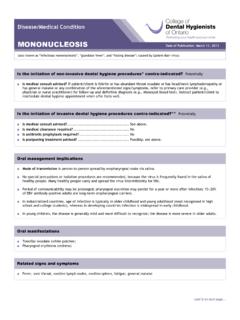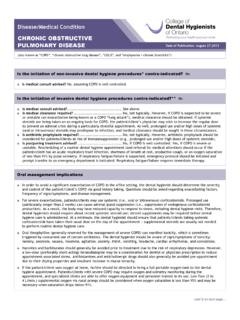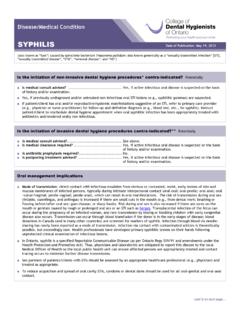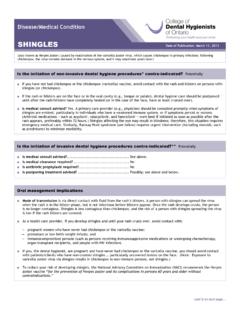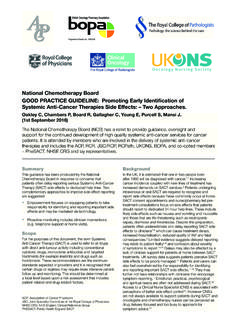Transcription of CDHO Advisory Chemotherapy
1 CDHO Advisory | Chemotherapy COLLEGE OF DENTAL HYGIENISTS OF ONTARIO Advisory . Advisory TITLE. Use of the dental hygiene interventions of scaling of teeth and root planing including curetting surrounding tissue, orthodontic and restorative practices, and other invasive interventions for persons 1 receiving or who have received Chemotherapy . Advisory STATUS. Cite as College of Dental Hygienists of Ontario, CDHO Advisory Chemotherapy , 2016-02-16. INTERVENTIONS AND PRACTICES CONSIDERED. Scaling of teeth and root planing including curetting surrounding tissue, orthodontic and restorative practices, and other invasive interventions ( the Procedures ).
2 SCOPE. DISEASE/CONDITION(S)/PROCEDURE(S). Chemotherapy INTENDED USERS. Advanced practice nurses Nurses Dental assistants Patients/clients Dental hygienists Pharmacists Dentists Physicians Denturists Public health departments Dieticians Regulatory bodies Health professional students Advisory OBJECTIVE(S). To guide dental hygienists at the point of care relative to the use of the Procedures for persons receiving or who have received Chemotherapy , chiefly as follows. 1. Understanding the medical condition. 2. Sourcing medications information. 3. Taking the medical and medications history. 4. Identifying and contacting the most appropriate healthcare provider(s) for medical advice.
3 1. Persons includes young persons and children Page |1. CDHO Advisory | Chemotherapy 5. Understanding and taking appropriate precautions prior to and during the Procedures proposed. 6. Deciding when and when not to proceed with the Procedures proposed. 7. Dealing with adverse events arising during the Procedures. 8. Keeping records. 9. Advising the patient/client. TARGET POPULATION. Child (2 to 12 years). Adolescent (13 to 18 years). Adult (19 to 44 years). Middle Age (45 to 64 years). Aged (65 to 79 years). Aged 80 and over Male Female Parents, guardians, and family caregivers of children, young persons and adults receiving or who have received Chemotherapy .
4 MAJOR OUTCOMES CONSIDERED. For persons receiving or who have received Chemotherapy : to maximize health benefits and minimize adverse effects by promoting the performance of the Procedures at the right time with the appropriate precautions, and by discouraging the performance of the Procedures at the wrong time or in the absence of appropriate precautions. RECOMMENDATIONS. UNDERSTANDING THE MEDICAL CONDITION. Terminology used in this Advisory Resources consulted Chemotherapy : Canadian Cancer Society Chemotherapy and You: National Cancer Institute Chemotherapy , chemo , cancer Chemotherapy , cancer medication therapy, cytotoxic Chemotherapy 1.
5 Is a method of treating cancer by using medications with the intention of a. curing cancer, to the extent that the Chemotherapy has destroyed the cancer cells so that they can no longer be detected, and that there is good reason to believe that they will not recur b. controlling cancer, to the extent that the Chemotherapy keeps the cancer from spreading, slows its growth, or destroys cancer cells that have spread to other parts of the body c. providing palliative care, to the extent that the Chemotherapy shrinks tumours that are causing pain or pressure. 2. comprises various types, including Page |2. CDHO Advisory | Chemotherapy a.
6 Combination Chemotherapy , destroying cancer cells with a mix of Chemotherapy medications b. neoadjuvant Chemotherapy , shrinking a tumour before surgery or radiation therapy c. adjuvant Chemotherapy , destroying cancer cells missed by the surgery or radiation d. ablative Chemotherapy , destroying existing bone marrow prior to its replacement by stem cells or bone marrow from a donor e. palliative Chemotherapy , reducing pain and other symptoms of cancer. 3. is also used to kill bacteria, viruses, fungi, and not only cancer cells. Other terminology used in this Advisory is as follows. 1. Cerebrospinal fluid a. circulates throughout the central nervous system within the spine and skull b.
7 Delivers nutrients to and removes waste from the brain and spinal cord c. cushions the brain and spinal cord against trauma. 2. Cytotoxicity, toxicity to or destructiveness of a cell. 3. Immunosuppression, when the response of the body's immune system is reduced or absent as a result of disease or treatment. 4. Myelosuppression, where bone marrow activity is decreased, thereby reducing the production of red blood cells, white blood cells, and platelets, which occurs as a side effect of some cancer treatments. Overview of Chemotherapy Resources consulted Cancer Chemotherapy : MedlinePlus Chemotherapy Side Effects At-A-Glance: National Cancer Institute Chemotherapy : Canadian Cancer Society Chemotherapy : MedicineNet Chemotherapy : PubMed Health Side Effects and Ways To Manage Them: National Cancer Institute Treating dental patients who are undergoing Chemotherapy : Canadian Dental Association, Point of Care Question 2.
8 Understanding Chemotherapy : Application of Chemotherapy has the intention of 1. curing a cancer 2. stopping a cancer from spreading 3. relieving symptoms of a cancer that is incurable. Treatment involves various types of Chemotherapy 1. varies considerably a. among patients/clients in the way it affects the cancer and in its side effects b. among cancer types c. in duration, pattern and frequency of delivery Page |3. CDHO Advisory | Chemotherapy 2. is delivered in specialized clinics in hospitals, though some Chemotherapy treatments can be delivered at home, which requires special support for family caregivers 3. includes medications that travel the bloodstream throughout the entire body, so that Chemotherapy is considered systemic treatment 4.
9 Is administered a. variously by i. mouth as tablets or capsules ii. injection 1. intra-muscular 2. intravenous 3. into the cerebrospinal fluid 4. by catheter inserted into a large vein close to the heart when treatment is required over lengthy periods b. along with radiation therapy (CDHO Advisory ) before, during or after the Chemotherapy c. may be accompanied by surgery or biological therapy d. most commonly in cycles which provide for periods of rest, sometimes lengthy 5. is routinely checked against clinical progress and adjusted accordingly 6. damages not only cancer cells, but also healthy ones though, over time, the healthy cells recover and repair themselves 7.
10 Renders persons vulnerable to infection, which accounts for a major proportion of deaths 8. may call for long-term or even life-long oral healthcare. Action of Chemotherapy 1. is most effective on cells that divide often to make new cells, a characteristic of most cancer cells 2. also damages normal, healthy cells, especially cells that divide quickly, including those in the a. oral mucosa, which may lead to oral side effects such as mouth sores b. blood c. hair d. lining of the gastrointestinal tract. Side effects 1. of Chemotherapy generally a. vary considerably from person to person even for a particular Chemotherapy medication, dependent on the i.




